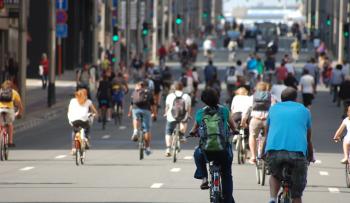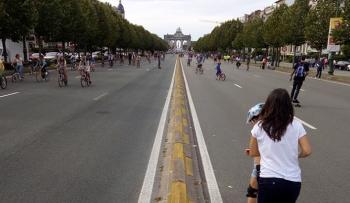
Car-free Day: A sneak-peek of the future of urban mobility
Car-free Sunday returns to Brussels on September 18, highlighting the incredible impact that reducing the amount of cars on city streets has on both air and noise pollution.
Friday 16 September marks the beginning of European Mobility Week, the European Commission’s flagship awareness-raising campaign for sustainable urban mobility. Over 2,341 towns and cities from 45 countries will be participating under the theme “Better connections”, as the campaign aims to foster synergies between people and places hoping to promote behavioural change in favour of active mobility.
One of the most popular actions being implemented across the continent is Car-free Day, when city streets are prohibited to drivers and road space is repurposed for activities such as walking, cycling and community activities. This year, one city is looking to make a particularly strong statement in its ambition to become more liveable for its citizens…
Brussels leads the way
On Sunday 18 September, Brussels will become Europe’s largest car-free zone, as the much-anticipated Car-free Sunday returns. The annual event provides a brief glimpse of an alternative urban landscape within the Belgian capital, one where streets are reclaimed from vehicles by the people, and active mobility, such as walking and cycling, is prioritised.
“Car-free Sundays show the city’s potential as a place to meet, to relax, to enjoy. It shows the effect of redistributing public space, offering more space to active modes, such as pedestrians and cyclists,” says Brussels Mobility Minister Elke Van den Brandt.
However, not only is Car-free Sunday a great day for residents to enjoy the outdoors and partake in fun community activities, it also provides a fantastic insight into how effective restricting car usage can be for reducing air and noise pollution. According to data from Brussels Environment, which presents a direct comparison between one of Brussels’ busiest intersections on a normal day and last year’s Car-free Sunday, there was a significant drop in the concentrations of several pollutants.
Elke Van den Brandt highlighting that air pollution is both an environmental and social issue (source: Twitter)
At the Arts-Loi/Kunst-Wet measuring station, for example, the concentrations of NO and NO2 decreased by 82 and 86% respectively, compared to an average Sunday. There is an even more pronounced drop compared to an average weekday, where the decrease was 92% and 91% respectively.
Regarding noise pollution, a strong decrease in background noise levels was measured at the various monitoring stations near roads. At monitoring stations at the edge of the E411 motorway in Auderghem and near the E40 in Woluwe-Saint-Lambert, there was a reduction of the acoustic pressure by 90%, while the measuring stations at Avenue Houba de Strooper/Houba de Strooperlaan near Laeken and Rue Guillaume Tell/Willem Tellstraat in Sint-Gillis recorded a 68% reduction in background noise.
A city in transition
While the popularity of Car-free Sunday in the Belgian capital is well-known and much-lauded, it represents only a small part of a much larger movement being undertaken by the local government. In August 2022, a new circulation plan was implemented in the Brussels city centre as part of the Brussels Capital Region’s “Good Move” mobility plan.
The new plan has restricted the movement of cars in several parts of the city centre with an overall aim to make local neighbourhoods more accessible, pleasant and safe for all modes of transport, including cycling. This circulation plan, as well as increased investment for cycling infrastructure, has already started to pay dividends for promoting active mobility in the city, with more people cycling. In this sense, Car-free Sunday represents not only a fun day out for the citizens of Brussels, but also an exciting prospect for the future; where cycling and sustainable mobility are prioritised to make the city a more liveable place.
“We are creating more cycling infrastructure in Brussels, which is reflected greatly in the amount of cyclists,” explains Van den Brandt. “In the two years after constructing the extra cycle lanes, the amount of cyclists has doubled, and we will continue to create more cycle lanes. In short, Car-free Sunday give us a sneak peek of the future of Brussels: a safer, healthier and more enjoyable city.”
Want to find out if your city is hosting a Car-free Day for European Mobility Week? Find out here.
The Brussels Capital Region is part of ECF’s Cities & Regions for Cycling Network, a network of cities and regions committed to promoting cycling as a mode of transport and leisure that collectively represents almost 50 million citizens across Europe and beyond. For more information on ECF’s CRC network and how to join, visit our Cities & Regions for Cyclists page.
Regions:
Contact the author
Recent news!
Upcoming events
Contact Us
Avenue des Arts, 7-8
Postal address: Rue de la Charité, 22
1210 Brussels, Belgium









